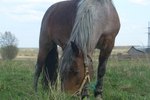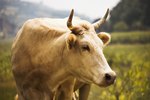
A few types of insects will infest improperly stored animal feeds. Large granaries and feed mills pay special attention to this problem to avoid product losses from infestations. Besides infestations, insects may inadvertently get in with your horse's feed during milling or baling of hay. Blister beetles, sometimes baled with alfalfa hay, can cause serious illness in horses. Feed infested by insects is not suitable for consumption by horses or any other animals.
Insect Infestation
Weevils, borers, moths and beetles are known to infest horse feed, particularly feed kept for longer than six weeks. Stored grain is more susceptible to insect infestations if the feed has high moisture content and the container has elevated temperatures. If your feed at home becomes infested by insects, you should throw away that feed and thoroughly disinfect your feed storage bin. If the problem persists, contact someone at the local feed mill for assistance. Never apply pesticides to feed or containers at home.
Blister Beetle Toxicosis
Blister beetles are toxic insects who live in alfalfa hay fields and are sometimes crushed and baled into the alfalfa hay. Blister beetles are commonly found in the Midwest, and have been seen as far south as Texas and as far north as South Dakota. As few as 25 beetles can be toxic to a horse. Symptoms of toxicity include increased urination, straining with urination, colic and low blood calcium levels. Blister beetle toxicity also causes "thumps" in horses. Thumps, a hiccuplike breathing pattern caused by contraction of the diaphragm in synchrony with the horse's heartbeat, results from low blood calcium levels. Blister beetle toxicosis can be fatal; it requires immediate veterinary attention. Alfalfa hay that is certified free of blister beetles is available through some hay dealers.
Other Contaminants
A variety of other contaminants may show up in horse feed and hay. Wire and string may be inadvertently baled into hay, for instance. Horses may ingest pieces of wire and get them stuck in their tongues or worse, they may injure their gastrointestinal tract. Dead rodents have been baled into hay and accidentally included in grain bags. Dead rodents are a potential source of botulism, which is extremely toxic and lethal to horses. If a dead rodent is found in a bale of hay or bag of grain, discard all of that feed immediately and notify the supplier. Carefully inspect horse feed for the presence of mold or mildew, discarding the feed if necessary.
Proper Storage
Store your horse's grain in a cool, dry area to help prevent contamination and infestation. The same conditions that cause insect infestations, high moisture and elevated temperatures, are the same conditions that lead to development of mold and mildew. Store feed in metal containers, instead of plastic, as rodents can chew through plastic to gain access to the feed. A separate feed room with a tightly latched door and concrete floors will protect feed from rodents and other pests.
References
Photo Credits
-
BananaStock/BananaStock/Getty Images



